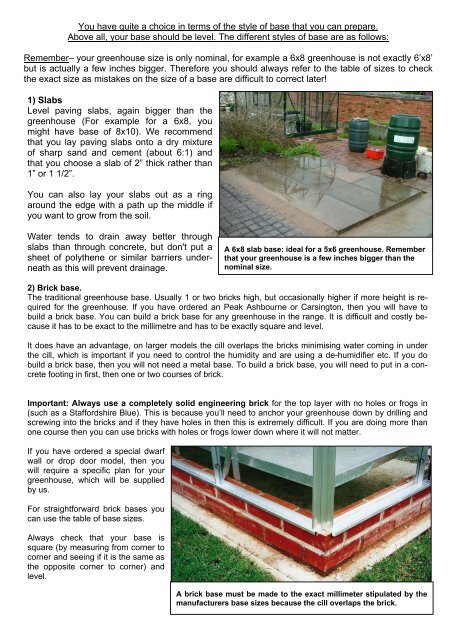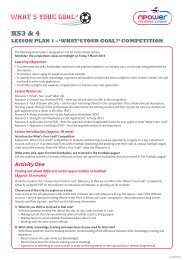Extra Information And Advice Booklet. Read Me Before ... - Npower
Extra Information And Advice Booklet. Read Me Before ... - Npower
Extra Information And Advice Booklet. Read Me Before ... - Npower
- No tags were found...
You also want an ePaper? Increase the reach of your titles
YUMPU automatically turns print PDFs into web optimized ePapers that Google loves.
You have quite a choice in terms of the style of base that you can prepare.Above all, your base should be level. The different styles of base are as follows:Remember– your greenhouse size is only nominal, for example a 6x8 greenhouse is not exactly 6’x8’but is actually a few inches bigger. Therefore you should always refer to the table of sizes to checkthe exact size as mistakes on the size of a base are difficult to correct later!1) SlabsLevel paving slabs, again bigger than thegreenhouse (For example for a 6x8, youmight have base of 8x10). We recommendthat you lay paving slabs onto a dry mixtureof sharp sand and cement (about 6:1) andthat you choose a slab of 2” thick rather than1” or 1 1/2”.You can also lay your slabs out as a ringaround the edge with a path up the middle ifyou want to grow from the soil.Water tends to drain away better throughslabs than through concrete, but don't put asheet of polythene or similar barriers underneathas this will prevent drainage.A 6x8 slab base: ideal for a 5x6 greenhouse. Rememberthat your greenhouse is a few inches bigger than thenominal size.2) Brick base.The traditional greenhouse base. Usually 1 or two bricks high, but occasionally higher if more height is requiredfor the greenhouse. If you have ordered an Peak Ashbourne or Carsington, then you will have tobuild a brick base. You can build a brick base for any greenhouse in the range. It is difficult and costly becauseit has to be exact to the millimetre and has to be exactly square and level.It does have an advantage, on larger models the cill overlaps the bricks minimising water coming in underthe cill, which is important if you need to control the humidity and are using a de-humidifier etc. If you dobuild a brick base, then you will not need a metal base. To build a brick base, you will need to put in a concretefooting in first, then one or two courses of brick.Important: Always use a completely solid engineering brick for the top layer with no holes or frogs in(such as a Staffordshire Blue). This is because you’ll need to anchor your greenhouse down by drilling andscrewing into the bricks and if they have holes in then this is extremely difficult. If you are doing more thanone course then you can use bricks with holes or frogs lower down where it will not matter.If you have ordered a special dwarfwall or drop door model, then youwill require a specific plan for yourgreenhouse, which will be suppliedby us.For straightforward brick bases youcan use the table of base sizes.Always check that your base issquare (by measuring from corner tocorner and seeing if it is the same asthe opposite corner to corner) andlevel.A brick base must be made to the exact millimeter stipulated by themanufacturers base sizes because the cill overlaps the brick.
















